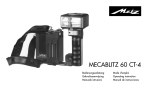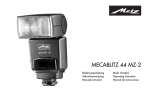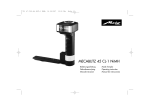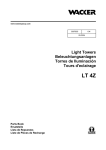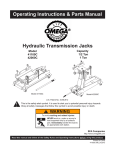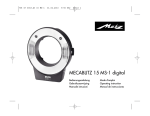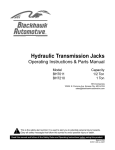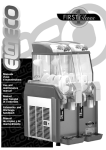Download Metz 28 CS-2 Camera Flash User Manual
Transcript
703 47 0165.A1 Inh. 03.08.2004 7:38 Uhr Seite 1 MECABLITZ 28 CS-2 digital Bedienungsanleitung Mode d’emploi Gebruiksaanwijzing Operating instruction Manuale istruzioni Manual de instrucciones 703 47 0165.A1 Inh. 03.08.2004 7:38 Uhr Seite 86 Foreword Contents: Congratulations on purchasing our flash 28 CS-2 digital and thank you for the confidence in our products. 1. Safety instructions 88 2. Preparations 89 2.1 Power supply 89 The following pages give useful instructions for proper operation of the flash unit and a survey of all its sophisticated functions. ķ 2.2 Loading and replacing the batteries 89 2.3 Mounting / Removing the flash unit 90 Please read these operating instructions carefully, even if one or the other point may not appear to be very insteresting at first sight. Although our designers have attached great importance to making the operation of the flash unit as simple as possible, the cameras with which it will eventually be used often offer a great diversity of capabilities. 2.4 Switching the flash unit on and off 90 Please also fold open the illustrated page at the end of these instructions. We wish you great pleasure with this new flash unit. 86 3. Flash coverage and reflector attachments 90 4. Slave mode 91 5. Switch on and shoot in EASY mode 91 6. Slave modes (SL) 93 6.1 Slave mode without preflash suppression 94 6.2 Slave mode with preflash suppression 95 6.3 Adapted slave mode 95 7. Settings for camera and flash unit 96 7.1 Cameras where operating mode, ISO and aperture can be set 97 7.2 Cameras where operating mode, ISO and aperture cannot be set 98 703 47 0165.A1 Inh. 03.08.2004 7:38 Uhr Seite 87 8. Flash modes 99 8.1 Auto flash mode A 99 11.3 Adapting the flash delay in slave mode with preflash suppression 106 8.2 Manual flash mode M 100 11.4 Re-establishing the flash unit settings 8.3 Metz-Remote Flash Mode SL 100 12. 8.4 EASY Mode 101 Troubleshooting, remedies and after-sales service 108 9. Flash parameters 102 13. Technical data 110 9.1 Automatic f-stop 102 9.2 ISO speed 102 9.3 Reflector status 102 9.4 Flash exposure correction value EV 103 9.5 Manual partial light output 104 10. Displays 104 10.1 Flash readiness indication 104 10.2 Correct exposure confirmation 104 10.3 Maximum flash range indication 105 11. 106 Special functions 107 ķ 11.1 Automatic switch-off function / AUTO-OFF 106 11.2 Meter-Feet changeover (m - ft) 106 87 703 47 0165.A1 Inh. 03.08.2004 7:38 Uhr Seite 88 1. Safety instructions • NEVER attempt to recharge dry batteries! • The flash unit is intended and approved only for photographical use. • Do not expose the flash unit to dripping or splashing water. • NEVER fire a flash from a very short distance directly into the eyes of persons or animals. This can cause damage to the retina and may even lead to blindness. • Do not expose your flash unit to high temperatures and humidity. Do not keep it in the glove compartment of your car. • NEVER trigger a flash in the vicinity of flammable gases or liquids (petrol, solvents, etc.), since this may cause EXPLOSIONS! ķ • NEVER shoot flash pictures of car or bus drivers, cyclists or motorcyclists, or train drivers while the vehicle is moving! This may dazzle the person concerned and result in an accident. • Only use the approved power sources specified in these operating instructions. • NEVER attempt to open or short-circuit batteries! • NEVER expose batteries to excessive temperatures such as intensive sunlight or a fire! • Remove exhausted batteries immediately from the flash unit. Such batteries may leak, releasing chemicals which can damage the flash unit. 88 • Do not touch the diffuser after firing several flashes at short intervals. Danger of burns! • When taking flash shots at full light output and in rapid succession observe an interval of at least 3 minutes after 20 flashes. • NEVER place material that is impervious to light in front of, or directly on the reflector. If this is not observed, the high energy of the flash light may cause burning or bleaching of the material or may damage the reflector. • NEVER dismantle the flash unit! DANGER: HIGH VOLTAGE! Repairs must only be completed by an authorised repair service. • Do not touch the contacts of the flash unit. 703 47 0165.A1 Inh. 03.08.2004 7:38 Uhr Seite 89 • The flash unit must not be used if the case has been so badly damaged that internal components are exposed. Remove the batteries! 2.2 Loading and replacing the batteries • Do not use defective batteries! • Turn off the flash unit by its main switch. 2. Preparations • Slide the battery compartment cover to the outside of the flash unit. 2.1 Power supply The flash unit can be operated with any of the following batteries: • 2 alkaline-manganese dry-cell batteries, type IEC LR03 (size AAA). Maintenance-free power source for moderate power requirements. • 2 nickel-metal-hydride batteries, type IEC HR03 (size AAA). They have a significantly higher capacity than NiCad batteries and are less harmful to the environment (no cadmium). They permit very fast recycling and are economical in use because they are rechargeable. • 2 NiCad batteries, type IEC KR03 (size AAA). the flash unit if you are not going to use it for an extended period of time. • Insert the batteries as indicated by the symbols in the battery compartment. ☞ When loading the batteries ensure that their + and - poles are aligned with the symbols. Transposed poles can destroy the flash unit. Always exchange both batteries, replacing them with identical batteries of the same capacity from the same manufacturer! Do not dispose of spent batteries in the domestic waste bin. Spent batteries should be handed in to an appropriate collecting point. • Close the battery compartment cover and slide it towards the unit’s foot. ☞ The batteries are exhausted if the recycling time exceeds 60 seconds when firing flashes at full light output. Remove the batteries from 89 ķ 703 47 0165.A1 Inh. 03.08.2004 7:38 Uhr Seite 90 2.3 Mounting / Removing the flash unit ☞ Turn off the flash by their main switch! Fold down the flash unit’s pivoted camera bracket. Secure the flash unit to the camera with the threaded tripod screw. To dismantle release the threaded tripod screw and remove the flash unit from the camera. Push the camera bracket forwards at the hinge and simultaneously fold upwards. 2.4 Switching the flash unit on and off To switch on set the main switch to “ON”. To switch off push the main switch down. ķ Automatic switch-off function / AUTO-OFF To save battery power and prevent inadvertent battery discharge the flash unit is factory-set to switch over to standby mode (AUTO OFF) approx. 8 minutes after: - switch-on, - a setting procedure, - firing a flash. The flash readiness signal and the indications on 90 the LC display go out. After automatic switch-off the last used settings are retained and instantly available when the flash unit is switched on again. The flash unit is reactivated merely by depression of any key (wake-up function). ☞ The flash unit should always be turned off by its main switch if it is not going to be used for an extended period of time. The automatic switch-off function can be deactivated whenever required (see Chapter 11.1). 3. Flash coverage and reflector attachments If there is no attachment in front of the reflector, the flash unit provides full lighting coverage for normal 24x36 mm shots with lenses as of 35 mm focal length. If a wide-angle diffuser (identified by W) is used the flash will cover the image angle of a 24 mm lens. When positioning the telephoto attachment (identified by T) in front of the reflector the flash unit will fully illuminate shots taken with a telephoto lens of 85 mm focal length and longer. 703 47 0165.A1 Inh. 03.08.2004 7:38 Uhr Seite 91 ☞ Please note that the effective range of the flash light is diminished by using a wideangle diffuser, and increased with a telephoto attachment . For digital cameras take into account that the focal lengths are given for the 35 mm format (see operating instructions of the individual camera). 4. Slave mode The slave mode is intended for cordless, delay-free triggering of one or more slave flash units. The slave is triggered by the light pulse from the flash unit built into the camera. Some digital cameras fire one or more measuring preflashes a fraction of a second before flash exposure. Normally, these measuring preflashes cannot be deactivated on the camera because they do influence, for example, the flash exposure. Moreover, a preflash function can be activated on many cameras to diminish the “red eye effect”. ☞ The internal photo cell sensor of the slave must be able to perfectly capture the light of the camera’s flash unit reflected by the sub- ject so that it can be triggered. The working range of the assembly depends on the intensity of the light pulse from the camera-integrated flash, the reflective properties of the subject and the prevailing ambient light. Please note that the working range is diminished outdoors and with bright ambient light. Avoid exposing the sensor to direct sunlight! 5. Switch on and shoot in EASY mode The EASY mode permits easy use of the slave flash unit for flash photography. Auto aperture, ISO speed rating, etc. do not have to be set on the flash unit. The EASY mode is a simplified automatic flash mode intended for digital cameras without setting capabilities, or the “Program P” and full auto modes. Prior to its first use, the slave has to be adapted to the technology of the flash unit built into the camera to find out if the camera-integrated flash unit works with or without preflashes. 91 ķ 703 47 0165.A1 Inh. 03.08.2004 7:38 Uhr Seite 92 Adapting the slave flash unit • Activate the camera’s internal flash unit. If necessary, switch on the camera’s red-eye reducing preflash function. • Turn on the slave flash unit by the main switch and wait for the flash readiness indicator to light up. • Keep the “Mode” key on the flash unit depressed for approx. 5 s until the symbols flash in an ascending sequence on the LC display. All other indications on the LC display and the flash readiness signal go out. ☞ To terminate briefly depress the “Mode” key. ķ • Take a picture of an appropriate subject (e.g. wall or ceiling of a room) at a distance of 2 m to 3 m with the camera’s internal flash. With the aid of this shot the 28 CS-2 establishes the number of preflashes fired by the camera-integrated flash unit and automatically stores the data. • The flash readiness indicator on the flash unit briefly lights up again to confirm the completed adaptation. 92 • The LC display indicates the symbol “SL ” for adapted slave mode, “EASY” flash mode and the maximum flash range (see Chapter 10.3). • The slave flash unit is now ready for operation. ☞ Flash unit adaptation only has to be completed once because the stored settings are retained, even when the flash mode is changed, the flash unit is switched off and the batteries are replaced. Adaptation must be renewed when the settings of the camera’s flash unit, the preflash mode (e.g. red-eye reducing preflash ON / OFF) or the camera are changed. ☞ The flash mode of cameras working with an automatically changing number of preflashes (e.g. Nikon 3D and D-TTL), as well as the Metz Remote Flash Mode, is not supported! Test shots Take some test shots with flash: The subject must be within the maximum flash range indicated on the LC display (see Chapter 10.3)! Assess the exposure results, e.g. on the camera monitor. 703 47 0165.A1 Inh. 03.08.2004 7:38 Uhr Seite 93 Depress the “+” key on the flash unit for a positive correction value when the flash shots are too dark, and the “-” key for a negative correction value when the flash shots are too bright. The correction value can be adjusted from +10 to -10. The setting becomes immediately effective and is automatically stored. The set correction value is taken over as the new zero value (“0”) for the next flash shot. Maximum flash range indication is adapted to the given correction value. ☞ If the slave unit is not triggered repeat the flash unit adaptation procedure and take another test shot. Tip: the camera-integrated flash. The important point is to know whether the flash unit built into your camera works with or without measuring preflashes. Selection of the slave mode determines whether the slave is triggered immediately after the first flash pulse from the camera’s flash unit, or whether one or more preflashes have to be suppressed before the slave is triggered together with the camera’s main flash. Select one of the three different slave modes by repeated combined depression of the “MODE” and pre-select keys. The selected slave mode flashes on the LC display of the flash unit. Establishing the slave mode suitable for your camera Carefully read the next chapters of these Operating Instructions to be able to make full use of all the capabilities of this flash unit. ☞ It is not necessary to establish the suitable 6. Slave modes (SL) Often it is rather difficult to establish whether or not a digital camera operates with preflash measuring technology. Proceed in the following manner to select the slave mode that is suitable for your camera: Selection of the slave mode suitable for your camera depends on the properties and technology of slave mode if you know whether or not your camera operates with preflash measuring technology! 93 ķ 703 47 0165.A1 Inh. 03.08.2004 7:38 Uhr Seite 94 • Activate the camera’s internal flash unit. • Deactivate the red-eye reducing preflash function on the camera. • Select on the slave unit the “M” flash mode with P 1/1 full light output (see Chapter 8.2). • Then select the slave mode without preflash suppression on the slave unit (see Chapter 6.1). • Take a test shot in which the reflector of the slave unit can be seen, for example in a mirror. ☞ NEVER look directly into the flash unit’s reflector ķ from a short distance as this could blind or injure your eyes! • Assess the test shot, e.g. on the camera monitor. adapt the slave automatically to your camera’s flash function (see Chapter 6.3). 6.1 Slave mode without preflash suppression SL This slave mode is suitable for all cameras working without measuring preflash technology. The slave is triggered at the same time as the flash unit incorporated in the camera. The light output of the slave is controlled by the selected flash mode (EASY, auto flash mode A or manual flash mode M). ☞ If your camera has a red-eye reducing preflash function, this function must be switched off! Otherwise it may be accidentally activated by flashes of other photographers working within the same action radius as the slave flash unit . • If the slave unit’s reflector is brilliantly illuminated in the test shot, then you have set the right slave mode for your camera. Settings on the slave flash unit • If the slave unit’s reflector is not bright or is dark on the test shot, then select on the slave unit a slave mode with preflash suppression (see Chapter 6.2) and take another test shot. Repeatedly depress the pre-select and “MODE” keys simultaneously until the symbol SL flashes on the LC display. The setting instantly becomes effective and is automatically stored after 5 s. • If this still proves to be unsuccessful, then select the adapted slave mode. This enables you to 94 703 47 0165.A1 Inh. 03.08.2004 7:38 Uhr Seite 95 6.2 Slave mode with preflash suppression SL This slave mode is specifically intended for digital cameras working with preflash technology. In this mode, the slave flash unit is not triggered by the measuring preflash but only by the main flash from the camera’s internal flash unit at the moment of exposure. The light output of the slave is controlled by way of the set flash mode (EASY, automatic A or manual M mode). ☞ The red-eye reducing preflash function must not be activated on the camera! The slave flash unit will only react to light pulses from the controller within a specific time (fractions of a second) , thus making it almost insensitive to the flash light of other photographers that are not working with preflash technology. Settings on the slave flash unit Repeatedly depress the pre-select and “MODE” keys simultaneously until the symbol SL flashes on the LC display. The setting instantly becomes effective and is automatically stored after 5 s. ☞ If necessary, you can modify the suppression of the preflash and reset the time between preflash and main flash for manual adaptation to your camera; see also Chapter 11.3. 6.3 Adapted slave mode SL This slave mode permits individual adaptation of the slave to the technology of the camera’s internal flash unit. It permits one or more red-eye reducing preflashes and one or more measuring preflashes of the integrated flash unit to be taken into account. The slave is triggered at the same time as the camera-internal flash unit firing the main flash for exposure. The light output of the slave unit is controlled by the selected flash mode (EASY, automatic A or manual M mode). Adapting the flash unit • Activate the integrated flash unit. If necessary, switch on the camera’s red-eye reducing preflash function. • Turn on the flash unit by the main switch and wait for the flash readiness indicator to light up. 95 ķ 703 47 0165.A1 Inh. 03.08.2004 7:38 Uhr Seite 96 • Set the required flash mode on the flash unit (A, M or EASY). • Keep the “Mode” and pre-select keys of the flash unit simultaneously depressed for approx. 5 s until the symbols start to flash in an ascending sequence on the LC display. All other data on the LC display, and the flash readiness indicator go out. ☞ Briefly depress the “Mode” key to terminate. ķ • The slave flash unit is now ready for operation. ☞ Flash unit adaptation only has to be completed once because the stored settings are retained, even when the mode is changed, the flash unit is switched off and the batteries are replaced. If necessary, adaptation can be renewed when the settings of the camera’s flash unit, the preflash technology (e.g. redeye reducing preflash ON/OFF) or the camera are changed. • Take a shot of an appropriate subject (e.g. wall or ceiling of a room) at a distance of 2 m to 3 m with the camera’s internal flash unit. On the basis of this shot the 28 CS-2 establishes the number of preflashes fired by the camera’s internal flash unit and automatically stores the data. ☞ The flash mode of cameras working with an • The flash readiness indicator on the flash unit lights up again and “o.k.” is indicated to confirm the completed adaptation. 7. Settings for camera and flash unit • The LC display indicates the symbol “SL ” for the adapted slave mode, together with the flash mode ( “A”, “M” or “EASY”) and the maximum flash range (see Chapter 10.3). 96 automatically changing number of preflashes (e.g. Nikon 3D and D-TTL), as well as the Metz Remote Flash Mode, is not supported! The slave unit can be operated together with your camera’s internal flash unit after the appropriate slave mode has been established or set. 703 47 0165.A1 Inh. 03.08.2004 7:38 Uhr Seite 97 7.1 Cameras where operating mode, ISO and aperture can be set and 9.2). Set the closest possible value where the exact value cannot be set. Camera setting Shoot some test pictures. Set on the camera the ISO speed rating. If possible avoid the AUTO-ISO setting! Set a negative flash exposure correction value on the flash unit when the shots are too bright, and a positive one when the shots are too dark (see Chapter 9.4). Compare the exposure results to establish the optimal setting for your camera. Set the camera’s operating mode to aperture priority A or Av or manual M (see the operating instructions for the given camera). Select the appropriate aperture manually in the aperture priority mode. The camera will then automatically set the corresponding shutter speed. Both the aperture and shutter speed are set manually on the camera when in manual mode. Activate the camera’s internal flash unit (see the operating instructions for the given camera). ☞ Use a tripod for slower shutter speeds (e.g. slower than 1/30 s) to avoid camera shake blur. Flash unit setting Auto flash mode A of the slave Set the same values for auto aperture and ISO on the slave as set on the camera (see chapter 9.1 When shooting pictures take into account the maximum flash range indicated on the flash unit’s LC display (see Chapter 10.3)! ☞ For cameras fitted with a zoom lens different flash exposure correction values may be necessary for the wide-angle and telephoto-range! Manual flash mode M of the flash unit Set the same values for aperture and ISO on the flash unit as set on the camera. Set the closest possible value where the exact value cannot be set. By selecting the full light output P 1/1 or a partial light output (see Chapter 9.5), you can determine the necessary camera-to-subject distance with the 97 ķ 703 47 0165.A1 Inh. 03.08.2004 7:38 Uhr Seite 98 aid of the maximum flash range indicated on the LC display (see Chapter 10.3). EASY MODE of the flash unit ☞ Select the operating mode Program P or full auto mode on the camera! Please refer to Chapter 5 for the setting of the EASY MODE. 7.2 Cameras where operating mode, ISO and aperture cannot be set Camera setting Activate the camera’s internal flash unit (see the operating instructions for the given camera). ķ Flash unit setting Auto flash mode A of the flash unit Set on the flash unit the value for the largest aperture opening (smallest f-number) of the camera lens and the camera’s ISO value (see Technical Data for the given camera). If this f-number and ISO value cannot be set on the flash unit, then set the next closest value. Take some test shots. 98 Set a negative flash correction value on the flash unit when the shots are too bright, and a positive one when the shots are too dark (see Chapter 9.4). Compare the exposure results to establish the optimal setting for your camera. When shooting pictures take into account the maximum flash range indicated on the flash unit’s LC display (see Chapter 10.3)! ☞ For cameras fitted with a zoom lens different flash exposure correction values may be necessary for the wide-angle and telephotorange! Manual flash mode M of the flash unit Set on the flash unit the value for the largest aperture opening (smallest f-number) of the camera lens and the camera’s ISO value (see Technical Data for the given camera). If this f-number and ISO value of the camera cannot be set on the flash unit, then set the next closest values. By selecting the full light output P 1/1 or a partial light output, the necessary camera-to-subject distance can be established by referring to the maxi- 703 47 0165.A1 Inh. 03.08.2004 7:38 Uhr Seite 99 mum flash range indicated on the LC display (see Chapter 10.3). EASY-MODE operation of the flash unit Please refer to Chapter 5 for the setting of the EASY MODE. 8. Flash modes Depress the “MODE” key repeatedly to select between the different flash modes: Automatic “A”, Manual “M”, Metz Remote Flash Mode “SL” (SLave) and “EASY”. The selected flash mode will flash on the LC display of the flash unit. 8.1 Auto flash mode A In automatic flash mode the photo cell sensor of the flash unit measures the light reflected by the subject. The flash unit interrupts light emission as soon as the necessary amount of light for a correct exposure has been reached. This means that a new aperture does not have to be calculated and set when the distance is changed, provided that the subject remains within the automatic flash range. The sensor has a measuring angle of 25° and only measures while the flash unit is emitting light. The measurement takes into account the light of the camera’s internal flash emitted at the same time as the light from the slave flash. ☞ If the duration of the flash from the camera’s internal flash unit exceeds that of the slave (e.g. with close-ups), then this can result in system-induced overexposure. For flash photography with digital cameras in slave mode it has proved to be useful to set a flash exposure correction value of approx -1 f-stop (-1 EV) for the camera-integrated flash unit. The correct exposure indicator will display “o.k.” for approx. 3 seconds when the shot was correctly exposed (see Chapter 10.2). Setting procedure Continue depressing the “MODE” key on the slave until “A” flashes on the display. The setting instantly becomes effective and is automatically stored after 5 s. Then set auto aperture, ISO and reflector status as flash parameters (see Chapter 9). ☞ Avoid exposing the sensor to direct sunlight! 99 ķ 703 47 0165.A1 Inh. 03.08.2004 7:38 Uhr Seite 100 8.2 Manual flash mode M 8.3 Metz-Remote Flash Mode SL In this mode the flash unit emits an uncontrolled flash at full light output (P 1/1) or partial light output (P 1/2, P 1/4, P 1/8 or P 1/16). The Metz-Remote Flash Mode permits cordless remote triggering of one or more off-camera slaves by a special on-camera master flash unit (controller). The slaves are controlled by the flash light from the master flash unit. The on-camera “master” (controller) must be able to support the cordless Metz Remote System (only with mecablitz 40 MZ-..., 50 MZ-5, 54 MZ-..., 70 MZ-...) and be switched to the corresponding operating mode (see the operating instructions for the controller). The light output is controlled by the camera (Metz-TTL-Remote Flash Mode) or by a photo cell sensor in the master flash unit (Metz Automatic Remote Flash Mode). Adaptation to the photographic situation is achieved by selecting the corresponding aperture and ISO setting on the camera and flash unit or by setting a partial light output (see Chapter 9.5). The LC display will then indicate the flash-to-subject distance to be maintained for a correct exposure (see Chapter 10.3). ☞ For system-induced reasons the light emitted ķ simultaneously by the camera’s internal flash unit is not taken into account. This may result in overexposure if the camera’s flash light dominates (e.g. with close-ups or small partial light output levels)! Setting procedure Continue depressing the “MODE” key on the slave until “M” flashes on the display. The setting instantly becomes effective and is automatically stored after 5 s. Then set aperture, ISO and reflector status as flash parameters (see Chapter 9). 100 Setting procedure Continue depressing the “MODE” key on the slave until “SL” flashes on the display. Additionally, “Ad1” is displayed to indicate the remote channel. The setting becomes instantly effective and is automatically stored after 5 s. The flash parameters do not have to be set on the slave. ☞ The slave flash unit only supports the Remote Channel 1 (the LC display indicates”Ad1”). 703 47 0165.A1 Inh. 03.08.2004 7:38 Uhr Seite 101 There is no maximum flash range indication nor correct exposure confirmation given in the Metz Remote Flash Mode. Testing the cordless Metz-Remote Flash Mode prior to exposure: • Position the slave and controller (master flash unit) as required for the intended shot. • Wait for flash readiness of controller and slave (flash ready indicator lights up). • Depress the manual firing button on the controller and fire a test flash. • The slave responds with a briefly delayed flash to indicate that it is ready for operation. When several slave units are being used then all slaves will acknowledge flash readiness simultaneously. • If a slave does not respond with a time-delayed flash, then this means that the unit’s sensor did not receive the controller’s light pulse. Change the slave’s position in such a manner that its sensor can capture the light pulse from the controller and repeat the test. • The slave flash unit is ready for use after the test has been successfully completed. ☞ Bright ambient light and/or a large aperture opening can result in the slave’s sensor receiving only an incomplete light pulse because the electronic circuit of the controller interrupts light emission prematurely. In this case stop down the lens aperture or mount a neutral density filter on the lens. The slave will only react to a light pulse from the controller. Flash units from other photographers working within the same area will not trigger the slave unit. The slave will not indicate flash readiness and maximum flash range in the cordless Metz Remote Flash Mode. Only the controller’s display is relevant for exposure indication. 8.4 EASY Mode Please refer to EASY Mode flash in Chapter 5. 101 ķ 703 47 0165.A1 Inh. 03.08.2004 7:38 Uhr Seite 102 9. Flash parameters 9.2 ISO speed For correct performance of the flash unit in the auto flash mode A and manual flash mode M it will be necessary to adapt the different flash parameters (f-stop, ISO speed, diffuser) manually to the settings on the camera. The adjusted flash parameters are retained after the flash unit has been switched off and after the flash mode has been changed. Continue depressing the pre-select key on the flash unit until “ISO” and the ISO value flash on the display. While the display is flashing depress the “+” or “-” key to adapt the ISO value on the flash unit to the camera’s ISO speed. ISO speeds from 50 to 3200 can be set. The setting becomes instantly effective and is automatically stored after 5 s. ☞ The flash parameter settings can only be changed in automatic flash mode A and manual flash mode M. Maximum flash range indication is automatically adapted to the adjusted flash parameters. ķ 9.1 Automatic f-stop Continue depressing the pre-select key on the flash unit until “F” and the f-stop flash on the display. While the display is flashing depress the “+” or “-” key to adapt the f-stop on the slave unit to the camera’s aperture setting. F-stops of f/1.4 to f/16 can be set in whole aperture increments. The setting becomes instantly effective and is automatically stored after 5 s. 102 9.3 Reflector status ☞ The reflector status cannot be set when in EASY Mode and in “SL” Metz-Remote Mode. To obtain correct indication of the maximum flash range and distance on the LC display, it is necessary to set the reflector status on the flash unit. This parameter indicates whether the flash unit is used without an attachment in front of the reflector, or with a wide-angle diffuser or telephoto attachment. Use of the wide-angle diffuser (“WIDE”) When using the 24 mm wide-angle diffuser (2.5 mm height) in front of the reflector, continue depressing the pre-select key until “WIDE or 703 47 0165.A1 Inh. 03.08.2004 7:38 Uhr Seite 103 “TELE” flash on the LC display. Then press the “-” key to set “WIDE”. Use of the telephoto attachment (“TELE”) When using the 85 mm telephoto attachment (7 mm height) in front of the reflector, continue depressing the pre-select key until “TELE” and / or “WIDE” flash on the LC display. Then press the “+” key to set “TELE”. Working without an attachment When using the flash unit without an attachment continue depressing the pre-select key until “TELE” and / or “WIDE” flash on the LC display. Then press the “-” and “+” keys until “TELE” and “WIDE” are simultaneously displayed. The setting becomes instantly effective and is automatically stored after 5 s. The display then indicates either “WIDE” or “TELE” depending on the setting. “WIDE” and “TELE” are no longer displayed after storage if no reflector attachment is used. Please refer to the instructions in Chapter 3. 9.4 Flash exposure correction value EV In various exposure situations it may be necessary to specifically influence the flash intensity of the slave flash unit, i.e. increase or decrease the intensity. A corresponding flash exposure correction value can be set on the flash unit for this purpose. ☞ A flash exposure correction value can only be set in the auto flash mode A! Continue depressing the pre-select key on the flash unit until “EV” and the correction value flash on the display. While the displays are flashing set the desired correction value between -3 and +3 EV- in one-third increments. The setting becomes instantly effective and is automatically stored after 5 s. After storage the LC display shows again the f-stop in place of the correction value and “EV” flashes to indicate that an exposure correction value has been set. To delete the correction value, set the correction value “0.0” on the flash unit. “EV” ceases to be displayed after automatic storage. 103 ķ 703 47 0165.A1 Inh. 03.08.2004 7:38 Uhr Seite 104 9.5 Manual partial light output ☞ Manual partial light output can only be set in manual flash mode M. Continue depressing the pre-select key of the flash unit until “P 1/” and the partial light output value flash on the display. While these data are flashing use the “+” or “-” key to set the required partial light output on the flash unit. Partial light output values of P 1/1 (maximum light output) to P 1/16 (minimum manual partial light output) can be set. The setting becomes instantly effective and is automatically stored after 5 s. After storage the LC display indicates again the f-stop ķ instead of the partial light output. 10. Displays 10.1 Flash readiness indication The flash readiness indicator on the slave flash unit lights up when the flash capacitor is fully charged to confirm that the slave is ready for firing. The slave will not be triggered if a shot is taken before the flash ready signal is lit. 104 When flash readiness is established a test flash can be fired with the “TEST” button. In the auto flash mode A and the manual flash mode M, this test flash is based on the adjusted flash parameters. In the Metz-Remote Flash Mode, the test flash has a low light output level. In the “EASY” mode a controlled test flash is fired, in conformity with the settings made. 10.2 Correct exposure confirmation The “o.k.” correct exposure indicator lights up for approx. 3 s when the shot was correctly exposed in the auto flash mode A or EASY mode. When in auto flash mode A this depends on the set flash parameters (see Chapter 9), and in the EASY mode on the selected light control. This enables you, for example in the automatic flash mode, to establish a suitable aperture by manually triggering a test flash. Fire a test flash with the manual firing button . If the “o.k.” correct exposure indicator does not light up then set the next smaller f- number, or reduce the distance to the subject, and repeat the test flash. 703 47 0165.A1 Inh. 03.08.2004 7:38 Uhr Seite 105 ☞ For the test flash, set up the slave unit (with incorporated sensor) in the same manner as for the subsequent shot. 10.3 Maximum flash range indication The maximum flash range is indicated on the LC display of the flash unit when in automatic A, manual M or EASY mode. For correct indication in automatic A and manual M mode it is necessary to manually adapt the flash parameters - aperture, ISO and reflector status - to the corresponding camera settings when a wide-angle diffuser or telephoto attachment is being used or when working without an attachment (see Chapter 9). ☞ The maximum flash range indication can be either in meters (m) or feet (ft) (see Chapter 11.2). Maximum flash range indication in the auto flash mode A and EASY MODE The LC display of the flash unit indicates the maximum flash range. The indicated value relates to a factor of 25% of light reflection by the subject, which applies to most photographic situations. Pronounced deviations from this reflection factor, e.g. highly reflective or poorly reflecting objects, can influence the maximum flash range of the flash unit. When shooting pictures, be sure to observe the maximum flash range indicated on the flash unit’s LC display. The subject should be within approx. 40% to 70% of the indicated value to give the electronic system sufficient leeway for compensation. The minimum flash-to-subject distance should not be less than 10% of the indicated value to avoid overexposure. Adaptation to the given photographic situation is possible by changing the aperture setting. Maximum flash range indication in the manual flash mode M The LC display of the flash unit indicates the distance to be maintained for correct flash exposure of the subject. Adaptation to the given photographic situation is achieved by changing the aperture setting and selecting between full light output and partial light output levels “P 1/1 to P 1/16” (see Chapter 9.5). 105 ķ 703 47 0165.A1 Inh. 03.08.2004 7:38 Uhr Seite 106 ķ Exceeding the display range • Turn on the flash unit by its main switch. The LC display of the flash unit can indicate a maximum range of 199 m or 199 ft. The display range of feet (ft) may be exceeded in the event of high ISO values and large aperture openings. This is signalized by the flashing of “199ft”. • Release the “MODE” key; “8m ON” will briefly appear on the LC display. 11.2 Meter-Feet changeover (m - ft) Proceed in the following manner to change between m / ft: 11. Special functions • Turn off the flash unit by its main switch. 11.1 Automatic switch-off function AUTO-OFF • Keep the The flash unit features a function to automatically switch-off if not used for 8 minutes. • Release the Deactivating AUTO-OFF • Turn off the flash unit by its main switch. • Keep the “MODE” key depressed. • Turn on the flash unit by its main switch. • Release the “MODE” key; “8m OFF” will briefly appear on the LC display. Activating AUTO-OFF • Turn off the flash unit by its main switch. • Keep the “MODE” key depressed. 106 pre-select key depressed. • Turn on the flash unit by its main switch. pre-select key. The display changes from “m” to “ft” or from “ft” to “m”. The selected unit of measurement is retained after the flash has been switched off or the batteries have been exchanged. 11.3 Adapting the flash delay in slave mode with preflash suppression The flash unit is factory-set to a delay period of 45 milliseconds (ms) between measuring preflash and main flash. This means that the flash unit will only be triggered if the time between the first measuring pre- 703 47 0165.A1 Inh. 03.08.2004 7:38 Uhr Seite 107 flash and the main flash is longer than 45 ms. This setting applies to most digital cameras. Digital cameras with different flash parameter settings usually offer the possibility to adapt the flash delay time. This may require the testing of several different settings. • Depress the setting. With some digital cameras the time between the measuring preflash and the main flash is shorter than 45 ms. To ensure that the slave flash unit can also be used with such cameras, the flash delay time has to be shortened. Other digital cameras operate with two clearly differing preflashes. The flash delay time of such cameras has to be lengthened. ☞ Please consult the technical support service of Setting procedure to adapt flash delay • Simultaneously keep the “MODE” and select key depressed. Test the slave mode with the changed setting. If the flash unit is not triggered at the desired time, then set a different flash delay time. the camera manufacturer if you have any questions concerning the flash technology of your camera. 11.4 Re-establishing the flash unit settings • Turn on the flash unit by its main switch. • Keep the prox. 10 s. • Turn off the flash unit by its main switch. pre- • Turn on the flash unit by its main switch. The symbol flashes on the LC display and the adjusted flash delay time is indicated in ms. • The flash delay time can be reduced or lengthened with the “-” and “+” keys. The setting range covers 5 ms to 255 ms. pre-select key to terminate the pre-select key depressed for ap- The following settings are made: • AUTO-OFF is turned on. • The slave operating modes are returned to the factory setting. • The maximum flash range indication is adjusted to “m” for meters. • The correction values and partial light output settings of the “EASY”, “A” and “M” flash modes are deleted. 107 ķ 703 47 0165.A1 Inh. 03.08.2004 7:38 Uhr Seite 108 12. Troubleshooting, remedies and after-sales service - Are the batteries correctly poled? Forming the flash capacitor • Yes: For technical reasons it is necessary to switch on the flash unit for approx. 10 minutes every 3 months (the capacitor incorporated in the flash unit undergoes a physical change if the flash unit is not switched on for prolonged periods). - Has the camera’s internal flash been activated? The batteries must supply sufficient power for flash readiness to be indicated within 1 minute after the unit was switched on. Please observe the following before contacting the after-sales service: ķ Problem: - Are the batteries fully charged? - Does the flash unit’s sensor receive the light pulse from the camera’s internal flash unit (controller)? Change the location or diminish the ambient light. Reduce the flash-to-subject distance. - Has the slave mode suitable for your camera been selected? Select the appropriate slave mode and adapt the flash unit automatically to your camera. - Have you selected the Metz Remote Mode SL? Switch to “EASY”, “A” or “M” flash mode. The slave flash unit does not fire a flash. Problem: Question: All shots are underexposed. Is the flash readiness indicator illuminated? Question: • No: Is the slave flash unit triggered at the correct time (main flash)? - Has the flash unit been switched on? - Has the flash unit automatically switched itself off? 108 • No: - Deactivate the red-eye reducing preflash function! 703 47 0165.A1 Inh. 03.08.2004 7:38 Uhr Seite 109 - The slave mode set on the slave flash unit is not suitable for your camera. Select a different slave mode! Unsuccessful troubleshooting • Yes: If, in spite of all hints, the flash unit still does not work, then please consult your local authorized dealer. - Check the flash parameters set on the slave flash unit! Adapt the unit’s flash parameters to the camera settings! Set a positive correction value. Turn off the flash unit by the main switch, wait for a brief moment and then switch the unit on again. Problem: All shots are overexposed. Check the flash parameters set on the slave flash unit! ķ Adapt the unit’s flash parameters to the camera settings! Set a negative correction value. 109 703 47 0165.A1 Inh. 03.08.2004 7:38 Uhr Seite 110 13. Technical data Guide number at ISO 100 / 21°: 28 (with telephoto attachment , 7 mm height) 22 (without attachment) 16 (with wide-angle diffuser , 2.5 mm height) Flash modes: EASY, Automatic A, Manual M, Metz-Remote SL Slave modes: Without preflash suppression With preflash suppression Adapted slave mode ķ Automatic apertures: f1.4 / f2 / f2.8 / f4 / f5.6 / f8 / f11 / f16 Manual light output settings: P 1/1, P 1/2, P 1/4, P 1/8, P 1/16 Light sensitivity: ISO 50 ... ISO 3200 Colour temperature: approx. 5600 K Flash duration: 1/300s ... 1/45000s 110 Recycling times with full-power flash: With alkaline manganese batteries approx. 8s With NiCad batteries approx. 6s With NiMH batteries approx. 6s Number of flashes with full light output: With alkali-manganese batteries > 100 With NiCad batteries (250 mAh) > 35 With NiMH batteries (700 mAh) > 100 Light coverage: rectangular Focal length in keeping with 35 mm format As of 24 mm with wide-angle diffuser (horizontal 75°, vertical ca. 55°). As of 35 mm without attachment (horizontal approx. 56°, vertical approx. 40°). As of 85 mm with telephoto attachment (horizontal apporx. 25°, vertical approx. 18°). Weight: approx. 140g (without batteries) Dimenions (w x h x d): 75.5 mm x 83 mm x 32.5 mm Included: Flash with telescopic bracket, attachments, Operating Instructions 703 47 0165.A1 Inh. 03.08.2004 7:38 Uhr Seite 168 Hauptschalter Interupteur général Hoofdschakelaar Main switch Interruttore principale Interruptor principal Ķ ĸ Betriebsartenwahl Sélecteur de mode Functieschakelaar Mode selector Selettore del modo di funzionamento Selección de modos de funcionamiento ń ķ ƴ Vorwahltaste und Belichtung o.k. į Présélection des fonctions et Exposition o.k. Voorkeuzetoets Belichting o.k.-aanduiding Preselector and exposure ok indicator Tasto di preselezione e indicazione di corretta esposizione Preselector del ajuste o indicación de exposición o.k. 168 703 47 0165.A1 Inh. 03.08.2004 7:38 Uhr Seite 169 Tasten für Wertverstellung Touches pour le réglage de la valeur Toetsen voor instellen van waarden Buttons for value adjustment Pulanti per la regolazione del valori Teclas para ajuste de valores Ķ ĸ ń Handauslösetaste und Blitzbereitschaftsanzeige Bouton d’essai et témoin de recyclage Ontspanknop voor handbediening en flitsaparaat-aanduiding Manual firing button and flash-ready indicator Pulsante test (emissione manuale del lampo) e indicazione di “pronto lampo” Tecla de disparo manual e indicación de disposición de disparo ķ ƴ į 169 703 47 0165.A1 Inh. 03.08.2004 7:38 Uhr Seite 170 Ķ ĸ ń ķ Standfuß, Pied, standvoet, Foot, Base d‘appoggio, Pie schwenkbare Kameraschiene Barrette pivotable zwenkbare camerabeugel Pivoted camera bracket Staffa della camera Regleta giratoria para la cámara ƴ Kamera- und Stativschraube Vis pour appareil photo et trépied camera- en statiefmoer Camera and tripod screw Vite camera e stativo Tornillo para cámara y trípode į Standfuß, Pied, standvoet, Foot, Base d‘appoggio, Pie 170 703 47 0165.A1 Inh. 03.08.2004 7:38 Uhr Seite 171 Ķ Fotosensor Senseur Fotosensor Sensor Sensore Foto Nicht abdecken! Ne pas masquer ! Niet afdeken Do not cover! Non coprire! No cubrir! ĸ ń ķ ƴ Sensor für drahtlosen Blitzbetrieb Cellule pour le mode flash sans fil Sensor voor draadloos flitsen Sensor for cordless flash control Sensore per il controlo flash distanza Sensor para el funcionamiento sin cable į 171 703 47 0165.A1 Inh. 03.08.2004 7:38 Uhr Seite 172 Batteriefachdeckel Couvercle du compartiment des piles Deksel batterijvak Battery compartment lid Coperchio del vano batteria Tapa del compartimento de pilas Ķ ĸ ń Servicebuchse - für den Fachhändler Connecteur S:A:V: - pour le revendeur Servicebus - voorde vakman Service socket - for service-technician Presa di servizio - per il revenditore specializzato Toma para servicio - Para el distribuidor ķ ƴ į 172 703 47 0165.A1 Inh. 03.08.2004 7:38 Uhr Seite 173 173 703 47 0165.A1 Inh. 03.08.2004 7:38 Uhr Seite 174 mecablitz 28 CS-2 digital für Digitalkameras mit eingebautem Blitzgerät for digital cameras with internal flash unit Art.-Nr. 002822008 Metz-Werke GmbH & Co KG Postfach 1267 • D-90506 Zirndorf Telefon (0911) 9706-0 • Telefax (0911) 9706-340 Internet: http://www.metz.de E-Mail: [email protected] Änderungen und Irrtümer vorbehalten ! Sous réserve de modifications et d’erreus ! Onder voorbehoudvan wijzigingen en vergissingen ! Errors excepted. Subject to changes! Riserva di modifiche e disponibilità di fornitura. Con reserva de modificaciones y posibilidades de entrega. Ķĸńķƴį Metz. Always first class. 703 45 0165.A1





































